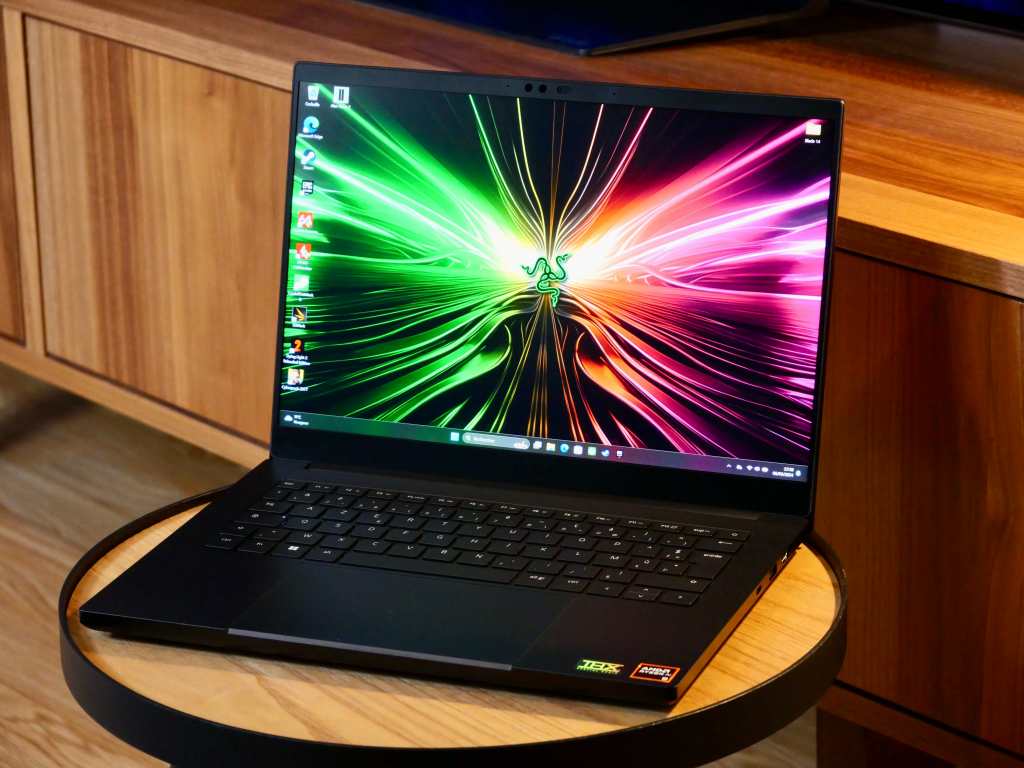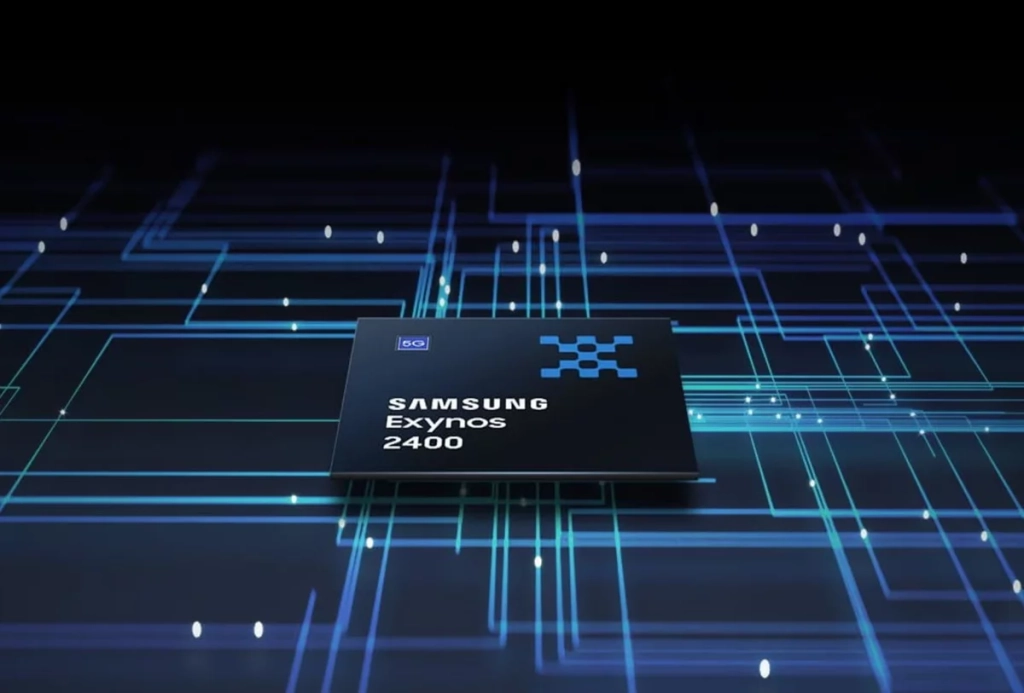The Razer Blade 14 returns at the start of 2024 in unchanged form, but with a new engine. Inside the small ultraportable gamer from the brand with the three snakes, an 8th generation AMD Ryzen processor and an NVIDIA GeForce RTX 4000 graphics card. Let’s see if this development gives it enough momentum in the face of competition that has time clearly strengthened… and much improved.

Renewed for CES 2024, the Razer Blade 14 does not benefit from the new features deployed over the last two years on its 16- and 18-inch big brothers, particularly in terms of chassis or display.
The excellent level of equipment that it could boast of two years ago compared to its competitors is no longer quite what it was… and this, while at least two of its rivals offer OLED screens and more modern chassis. We are thinking in particular of the very good ASUS ROG Zephyrus G14 2024 (redesigned from the ground up) and the future HP Omen Transcend 14 (completely new to the HP catalog).
Design: the same, with the same qualities… and yet cannot be removed
At 310.7 x 228 x 17.99 mm for 1.84 kg, the Blade 14 2024 is a little more bulky, thicker and heavier than the 2022 model that we tested two years ago. A difference of a few grams and a few millimeters, which does not really work against this new version.
In terms of grip, the machine remains very compact and relatively light, even if it is still significantly stockier than an Alienware X14 or the new ROG Zephyrus G14 mentioned above. This (slightly) larger footprint does not only have disadvantages, however. In particular, it allows the integration of a graphics card with a larger thermal envelope than its rival from ASUS. We’ll talk about this in more detail a little further down.

Regardless, Razer once again confronts us with a CNC machined aluminum chassis, available in black or metallic gray. Particularly sober, stripped of any embellishment (with the exception of a backlit Razer logo centered on the cover), the new Blade 14 does not change anything from the design that we already know about it. We are therefore once again benefiting from an elegant product, with meticulous assembly and meticulous finishes… which on the other hand always has the disadvantage of being very sensitive to fingerprints.
On the keyboard side, we find the same thing as in 2022, with “chiclet” keys well separated from each other, but a little small, quite noisy, and not offering sufficient travel depth to offer optimal comfort in gaming. In office use, however, this keyboard remains pleasant, at least once you get used to its relative narrowness.
On the other hand, we blame Razer for still not taking into account a constructive criticism, formulated by many users, concerning the backlighting of its keyboard. The Blade 14’s keys are therefore still not fully illuminated. Understand that only certain characters are visible when working at night. A horror, especially if you need to type numbers, or punctuation elements.

The trackpad housed under this keyboard has the advantage of being large. This XXL sliding surface is pleasant and you benefit from good precision as a bonus. Only the pressed clicks (a little hard) are frustrating, but overall, the Blade 14 is a pretty good student in this area. That said, Apple’s haptic trackpads are very clearly above the fray. In this regard, the MacBook Pro 14, for example, therefore remains unbeatable.
The Blade 14 makes up for it with a well-stocked connectivity section. There are indeed two USB-A 3.2 Gen 2 ports, two USB4 Type C ports, an HDMI 2.1 output and a 3.5 mm jack socket. Everything you need to be happy, especially since these connectors are well distributed on either side of the chassis. At the same time, we appreciate the presence of a quality 1080p webcam, housed above the screen, and compatible with facial identification by Windows Hello. Fortunately, because the Blade 14 does not have any fingerprint reader at its service.
Finally, let’s talk about the audio part of the device. The latter has two speakers installed on each side of the keyboard. The best place on a laptop, in our opinion, since they are pointed towards the user and not against the desktop. That said, the Blade 14 does not perform miracles. The sound delivered is good, but the overall audio experience is not as good as that offered by the numerous speakers of the latest G14, or those of the MacBook Pro 14.
Without transition, access to the components is done by removing the bottom plate of the chassis, fixed using small torx screws. In this area, Razer allows us to easily replace the RAM (two DDR5 modules in SO-DIMM format), the SSD (M2 2280 module) and the battery. This is better than the two competing models mentioned above. The RAM of the new Zephyrus G14 is, for example, soldered to the motherboard.

Screen: the competition now does better, for less money
If more and more competitors opt for an OLED panel offered as standard (this is the case of the Omen Transcend 14 from HP as well as the new ROG Zephyrus G14 from ASUS, in particular), Razer is once again sticking to a “ simple » 14-inch IPS LCD screen for its Blade 14 from 2024.
Compared to the organic panels of its rivals, the device therefore loses contrast and responsiveness (the response time of OLED screens being practically zero), but is almost equal in terms of definition (2560 by 1600 pixels here compared to 2880 by 1800 pixels on the two aforementioned models), and offers a higher refresh rate (240 Hz here compared to 120 Hz opposite). We regret, however, that VRR is only ensured through the AMD FreeSync Premium solution. At this price level (2,500 euros minimum), NVIDIA G-Sync certification would still have been appreciable.

Under our measurement tools, the panel chosen by Razer nevertheless does a good job. In fact, we measure a maximum brightness of 412 cd/m2. A value higher than that found on the Blade 14 two years ago, and which offers good readability in the vast majority of contexts of use… especially since the anti-reflective treatment applied to the screen seemed effective to us. Without approaching the sensational values of OLED, the contrast offered by the screen of our new Blade 14 remains very honest – at least for an LCD panel. We indeed note a ratio of 1932:1, again higher than what we measured on the device in 2022.
As promised, support for the DCI-P3 color space is comprehensive with an index of 99.4% based on our measurements, while the sRGB gamut is 99.9% covered. The DeltaE, for its part, does not exceed 1.4, reflecting very good colorimetric fidelity, and the color temperature is relatively fair by default.
Clearly, we benefit from a great display experience overall… even if the absence of OLED (which has just arrived on the Blade 16), or Mini-LED (available as an option on the Blade 16 since 2023), leaves us with an aftertaste of “not enough” in the mouth.
Performance: the most powerful 14 inch on the market?
Our Razer Blade 14 2024 is equipped with an AMD Ryzen 9 8945HS processor (8 cores/16 threads, 16 MB L3 cache, boost up to 5.2 GHz), coupled with 32 GB of RAM (DDR5 at 5600 MHz) and a dedicated NVIDIA GeForce RTX 4070 (140 W) graphics card. On paper, the latter therefore offers a technical sheet extremely close to that of the latest high-end ROG Zephyrus G14, which is distinguished for its part by the use of LPDDR5X memory (faster), but also – and unfortunately – by a RTX 4070 limited to a thermal envelope of 90 W… or 50 W less at full power than that of our Blade 14.
Let’s see how the latter behaves in game and in benchmarks.
In terms of CPU performance, and on Cinebench R23, we first note an index of 16,182 points in multi-core, compared to 1,771 points in single-core. Advantageous figures. The same Ryzen 9 8945HS, but this time on the ROG Zephyrus G14 2024, this time rose to 16,631 points in multi-core calculation, but was limited to 1,684 points in single-core. Overall, the performance of the AMD chip (under Zen 4 architecture, engraved in 4 nm by TSMC) is therefore well exploited on the new Blade 14, even if the latter does not perform miracles in the context of calculations. carried out on all 8 processor cores. In this context, the format of the device and its compact dissipation system inevitably imply some concessions.
However, it is difficult to dislike Razer’s new ultraportable in terms of cooling. On this point the device turns out to be impeccable, avoiding both thermal throttling on the CPU, but also limiting heating in game as well as in intensive use… at least that perceptible by the user. In this regard, even after several hours of play or a major stress test, the heat is almost imperceptible at the keyboard, and very bearable near the hinge. On this point the Blade 14 therefore does better than its rival from ASUS. Finer, the latter was indeed illustrated by a more marked heating.

That being said, both devices are about as noisy as each other in gaming or sustained use. Although not unbearable, the noise emitted by the Blade 14’s fans is difficult to ignore. The device, on the other hand, has the merit of being perfectly silent in office use, web browsing, or light multimedia, since its fans are cut off most of the time, or run at very low speed.
In terms of graphics performance, the Razer Blade 14 2024 easily ranks at the top of the best gaming ultraportables. It’s quite simple, the device is a monster of power barely more bulky than a school notebook. On 3D Mark Time Spy Extreme, the machine and its RTX 4070 (140 W) collected 5,966 points in graphics score. For comparison, the Blade 14 2022 and its RTX 3080 Ti rose to 4,936 points two years ago; while the ROG Zephyrus G14 2024 and its RTX 4070 (90 W) are satisfied with 5,371 points in graphics score on the same tool.
Still on Time Spy Extreme, the RTX 4070 of the HP Omen Transcend 16 reached “only” 5,813 points on the same benchmark. Clearly, the new Blade 14 manages to do better than certain “large” 16-inch models despite its ultra-compact 14-inch format. Hats off.
Under these conditions, in-game performance is generous. In QHD+ (native definition of the Blade 14), we reach the 50 FPS mark on average on Cyberpunk 2077 with the “Ray-tracing ultra” preset. A threshold well exceeded, with more than 70 FPS on the clock, when NVIDIA’s “frame generation” technology (DLSS3) is activated. Under the same conditions, this time under Dying Light 2, we recorded an average above 80 FPS, compared to more than 100 FPS with DLSS 3.0 active.
As for Alan Wake 2 , with all the settings in ultra, active path tracing, and the most demanding settings available to date, we were able to animate it at 30-35 FPS on average with DLSS 3 activated . By making a few concessions, it is obviously possible to exceed 60 FPS, but with these extreme settings, the game was truly beautiful… while remaining relatively fluid.
Of course, the 100 FPS bar will be happily exceeded in competitive titles, which require less resources, and these performances give us free rein for all the creative uses that we can imagine (3D modeling, heavy video editing, photo editing advanced…). The Blade 14 is quite simply a very nice (small) reservoir of power, enough to meet the expectations of both gamers and creative users looking for a compact product with devilish performance.

Let’s finish with an update on the transfer speeds obtained on the 1 TB SSD installed on board our loaner Blade 14. On CrystalDiskMark, this M.2 PCIe Gen 4 card reaches 6,665.95 MB/s reading and 4,936.43 MB/s writing. Enough to work, create and play in generally optimal conditions.
Autonomy: one (small) day on battery
With its 68.1 Wh battery, the Blade 14 2024 has a capacity almost identical to that of the 2022 model… despite the move to more powerful components. Enough to make us fear the worst at first glance. In fact, Razer is doing quite well. In light use, the 7 hour mark can be reached provided that you reduce the wind in terms of screen brightness, and avoid any RGB backlighting galore on the keyboard.
In video playback on YouTube, with the screen brightness pushed to 100%, this time, the keyboard backlight disabled and the power settings in best efficiency mode, we managed to slightly exceed 6 hours 10 minutes of autonomy . Not enough to break the champagne, but the Blade 14 is therefore capable of lasting a short day on battery if we put our effort into it.

However, you will need to keep the charger close at hand to avoid any unpleasant surprises along the way. Rather compact (GaN requires), the latter can be transported quite easily with the device. It allows you to recover 100% of the battery in more or less 1 hour 30 minutes on mains power. We will also add that the Power Delivery technology available on the Blade 14 also allows you to refuel, sometimes slowly, of course, but with more or less any USB-C charger that is even a little powerful. Practical.
Razer Blade 14 (2024): TechAint’s opinion
Powerful, not too prone to heating and equipped with a super fast screen, the Blade 14 does not suffer from any major fault and even manages to surprise with the impeccable performance of its RTX 4070, perfectly exploited despite the 14-inch format . Razer’s new ultraportable is therefore a hit, without however taking away the impression that the brand with the three snakes could do even better in 2024.
More expensive than the competition with equivalent configuration, the device suffers from the absence of an OLED screen to completely transform the test, and inflicts on us, once again, a poorly backlit keyboard which annoyed us throughout of our test. Enough to dissuade us from giving it the rating – even more flattering – that we would have liked to give it. To the wise…





Leave a comment